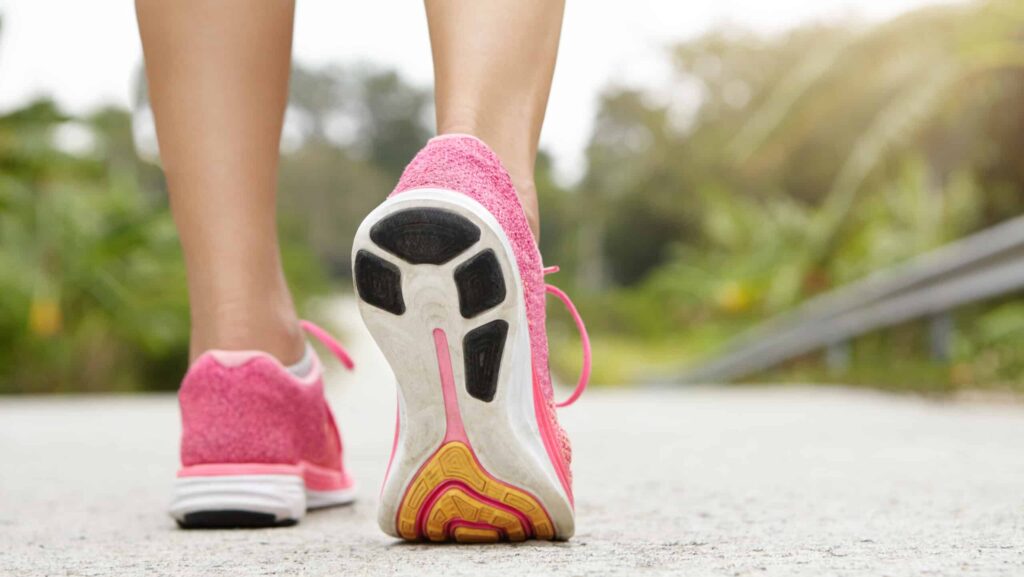Finding the perfect pair of running shoes can be a game-changer for any runner. For women, the right running shoes are about comfort, injury prevention, and enhancing performance.
Women’s Shoes can be challenging to choose from, with many options available. This guide will help you understand your foot type and provide practical tips on finding the best women’s running shoes to meet your needs.
Understanding Your Foot Type
Before diving into specific shoe recommendations, it’s essential to understand your foot type. There are three primary foot types: neutral, overpronation, and supination (underpronation). Each type affects how your foot strikes the ground and rolls through your stride.
- Neutral Foot Type: Neutral runners have a natural arch and balanced foot movement. The foot lands on the heel and rolls forward evenly, distributing the impact.
- Overpronation: Overpronators have a low arch or flat feet. Their feet roll inward excessively after landing, leading to various injuries.
- Supination (Underpronation): Supinators have a high arch, causing their feet to roll outward upon impact. This can result in stress on the outer edge of the foot and other injuries.
Determining Your Foot Type
To determine your foot type, you can use the wet test, visit a specialty running store, or consult a podiatrist. Here’s a quick guide to the wet test:
- Wet the bottom of your foot.
- Step onto a piece of paper or cardboard.
- Observe the footprint left behind.
- Neutral Arch: A distinct curve along the inside of the foot, with a band connecting the heel and the ball of the foot.
- Low Arch (Overpronation): A nearly complete footprint with minimal curve along the inside.
- High Arch (Supination): A narrow band connecting the heel and the ball, or no band at all.
Features to Look for in Women’s Running Shoes
Once you know your foot type, consider these features when selecting running shoes:
- Cushioning: The amount of cushioning you need depends on your running style and preference. Cushioning can help absorb impact, making runs more comfortable.
- Neutral Runners: Moderate cushioning.
- Overpronators: Extra cushioning to support the arch and prevent inward rolling.
- Supinators: More cushioning to compensate for the high arch and absorb shock.
- Support and Stability: Shoes with appropriate support help maintain proper alignment and reduce injury risk.
- Neutral Runners: Standard support.
- Overpronators: Stability or motion control shoes with added support features.
- Supinators: Flexible shoes with cushioning and minimal support structures.
- Fit and Comfort: A well-fitting shoe is crucial for comfort and performance.
- Toe Box: Ensure there’s enough room for your toes to move freely.
- Heel Counter: A snug heel counter to prevent slipping.
- Overall Fit: The shoe should feel comfortable without tightness or pressure points.
- Durability and Traction: Depending on where you run (road, trail, treadmill), consider the outsole’s durability and traction. Road runners need shoes with good grip on asphalt, while trail runners need more rugged soles for off-road terrain.
Top Picks for Different Foot Types
Based on foot type, here are some top recommendations for women’s running shoes:
- Neutral Foot Type:
-
- Asics Gel-Nimbus: Known for its balanced cushioning and support, ideal for neutral runners.
- Brooks Ghost: Offers excellent cushioning and a smooth ride.
- Nike Air Zoom Pegasus: A versatile shoe with good support and responsiveness.
- Overpronation:
-
- Brooks Adrenaline GTS: Provides excellent stability and support for overpronators.
- Asics Gel-Kayano: Combines cushioning with stability features.
- Saucony Guide: Offers structured support to correct overpronation.
- Supination (Underpronation):
-
- Brooks Glycerin: High cushioning to absorb shock and support high arches.
- Asics Gel-Cumulus: Balanced cushioning and flexibility for supinators.
- New Balance Fresh Foam 1080: Provides plush cushioning and a comfortable fit.
Tips for Trying on Running Shoes
- Shop Later in the Day: Your feet swell throughout the day, so shopping in the afternoon or evening ensures a better fit.
- Wear Running Socks: Try on shoes with the socks you typically wear during runs.
- Allow for a Thumbnail’s Width: Ensure there’s about a thumbnail’s width of space between your longest toe and the end of the shoe.
- Test on a Treadmill: Test the shoes on a treadmill to simulate running conditions.
- Pay Attention to Comfort: Comfort is key. If a shoe feels off, try a different size or model.
Maintaining Your Running Shoes
To get the most out of your running shoes, follow these maintenance tips:
ADVERTISEMENT
- Rotate Shoes: Alternate between two pairs to extend their lifespan.
- Replace Regularly: Most running shoes last between 300 and 500 miles. Replace them when you notice signs of wear or reduced support.
- Clean Properly: Hand wash your shoes with mild soap and water, and let them air dry. Do not use a washing machine or dryer.
Conclusion
Finding the best women’s running shoes for your foot type is crucial in ensuring a comfortable, injury-free running experience. Understanding your foot type and considering the features that cater to your specific needs can help you make an informed decision. Remember to prioritize comfort, fit, and the specific requirements of your running style. Happy running!









